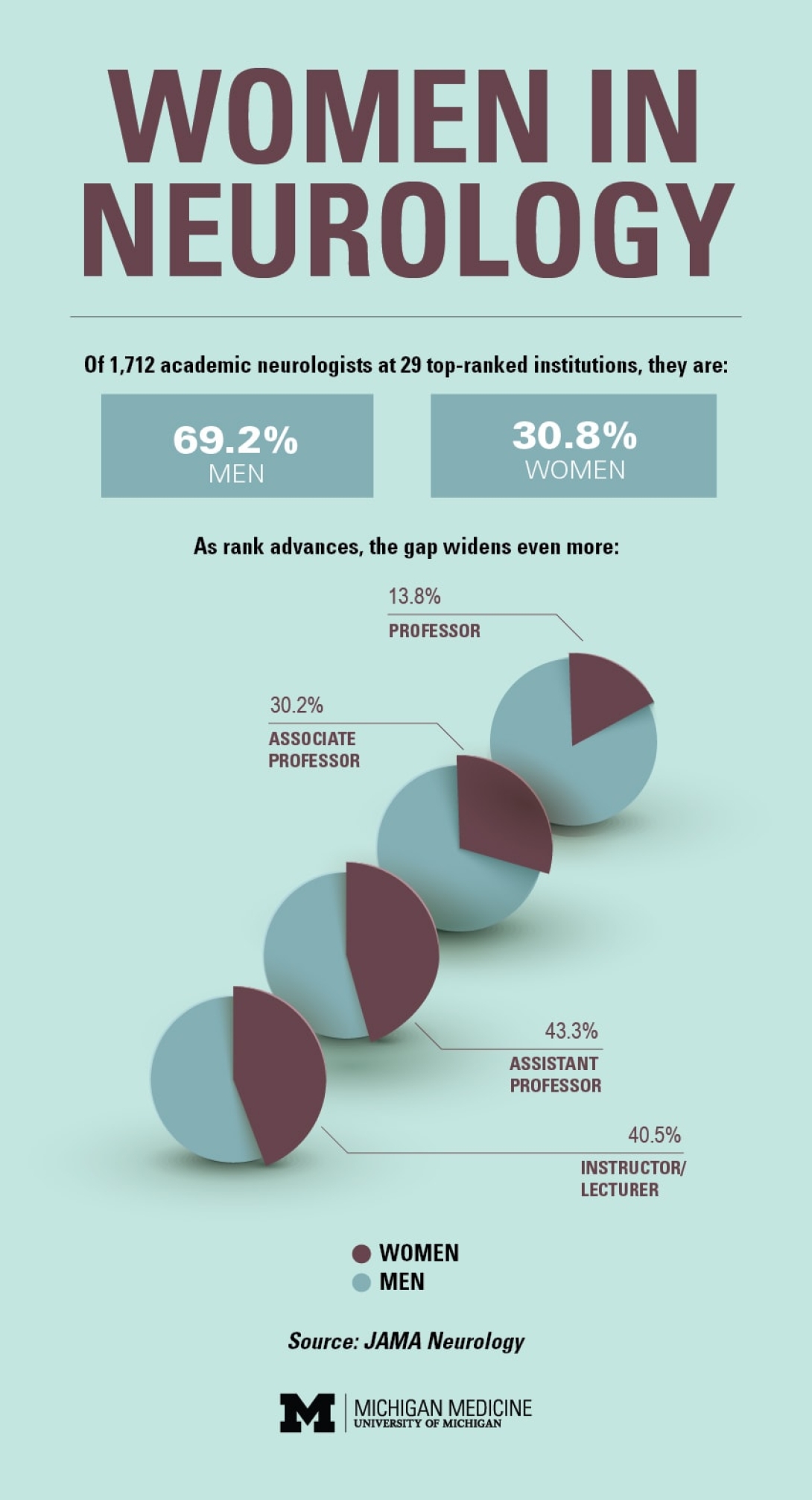Men and women now enter medical school in near-even numbers, but fewer women pursue neurology careers — with gaps increasing by seniority.
7:00 AM
Author |

As a medical student and resident, Mollie McDermott, M.D., found no shortage of coursework and literature to nurture her interest in neurology. And the teachers and colleagues she encountered were "smart, quirky and self-effacing."
Many, however, were men.
MORE FROM THE LAB: Subscribe to our weekly newsletter
"I'm constantly on the hunt for female mentors," says McDermott, now an assistant professor of neurology at Michigan Medicine, a role she has held since 2016.
That personal experience is reflected more widely in a new observational study of 1,712 academic neurologists employed at 29 top-ranked medical institutions in the United States. Published in JAMA Neurology, the research examined gender balance by academic rank and publication rate.
The divide, McDermott and her colleagues found, was stark: Women hold slightly fewer than one in three academic neurology jobs.
Results were obtained by analyzing faculty bios from institutional websites. The study co-authors controlled for the number of years since medical school graduation. They also performed secondary analyses that included each doctor's Scopus-h index and clinical activity as inferred through Medicare claims data.
Among the surveyed group, men outnumbered women at all faculty ranks — with the split growing wider as seniority increased.

And while the number of academic papers published by male neurologists surpassed that of women at all levels, the gap narrowed with advancing rank.
Such disparity isn't unique to neurology, McDermott notes. Among medical residents, male-dominated specialties include radiology, anesthesiology and emergency medicine.
But the study results, coupled with the fact that more women than men are now enrolled in medical school, should inspire institutions to strive for better balance.
Says McDermott: "We want to be able to recruit the strongest female students into neurology."
Publishing rates play notable role
Despite the overall gender imbalance in neurology ranks, the study found no major differences between men and women in other levels of academic productivity — including clinical activity, educational leadership and book authorship.
SEE ALSO: Women in Medicine Say #MeToo, Report 'Appalling' Experiences
Still, the quantity of published research is often considered a key benchmark in evaluating and awarding academic job promotions.
Which means addressing that issue, no matter the root cause, is important.
"In our opinion, publication rate is relied on disproportionately," McDermott says of the tendency to prioritize the number of a candidate's published works. "But it is a very accessible metric that can be easily compared among individuals."
Part of this split, McDermott hypothesized, could be explained by more female academic neurologists pursuing a care- or education-centered clinical track rather than an instructional track that focuses more heavily on scholarship and research. (Her study did not directly evaluate this hypothesis; information regarding each physician's academic track wasn't publicly available.)
Other issues, both work-related and not, might also contribute. Women continue to bear a heavier load than men in balancing work and family.
Likewise, "It may be the case that women have more administrative or educational service responsibilities that contribute to their departments in important ways but aren't reflected in [their] publication rates," McDermott says.
"I think one big takeaway is that when we look at academic promotion for female and male neurologists, publication rate is important but is not the only factor that should go into that decision."
Culture creates comfort, opportunity
Beyond examining the pillars of hiring practices, promoting a culture of diversity and inclusion is important to attract women to pursue academic neurology — and, as McDermott notes, to keep them from going into private practice, "if we can keep them practicing at all."
That's a goal McDermott is confident that medical institutions can achieve with targeted outreach and advocacy.
SEE ALSO: 'A Seat at the Table': Why U-M's Medical School Wants More Students with Disabilities
"Mentorship is very, very important and will become increasingly available as there are more women in neurology and in advanced ranks," she says. "And we need to ensure that female neurologists have a presence on the national stage, by serving on leadership and writing committees and having access to resources for career development."
Although women made up only 26.9 percent of the 13,142 active neurologists in 2013, they constituted 44.9 percent of neurology residents that same year, according to the Association of American Medical Colleges — a shift that could indicate small steps to lasting progress.
The value of that progress, of course, extends to any profession.
"We certainly all benefit when disparities are reduced, whether it be gender, race or disability," McDermott says. "We want to make sure neurology is a field that is equitable, accessible and one in which women feel supported and empowered."

Explore a variety of health care news & stories by visiting the Health Lab home page for more articles.

Department of Communication at Michigan Medicine
Want top health & research news weekly? Sign up for Health Lab’s newsletters today!





